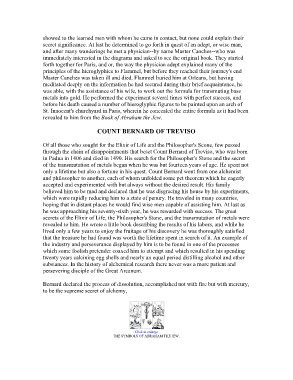Page 431 - The_secret_teachings_of_all_ages_Neat
P. 431
showed to the learned men with whom he came in contact, but none could explain their
secret significance. At last he determined to go forth in quest of an adept, or wise man,
and after many wanderings he met a physician--by name Master Canches--who was
immediately interested in the diagrams and asked to see the original book. They started
forth together for Paris, and or, the way the physician adept explained many of the
principles of the hieroglyphics to Flammel, but before they reached their journey's end
Master Canches was taken ill and died. Flammel buried him at Orleans, but having
meditated deeply on the information he had secured during their brief acquaintance, he
was able, with the assistance of his wife, to work out the formula for transmuting base
metals into gold. He performed the experiment several times with perfect success, and
before his death caused a number of hieroglyphic figures to be painted upon an arch of
St. Innocent's churchyard in Paris, wherein he concealed the entire formula as it had been
revealed to him from the Book of Abraham the Jew.
COUNT BERNARD OF TREVISO
Of all those who sought for the Elixir of Life and the Philosopher's Scone, few passed
through the chain of disappointments that beset Count Bernard of Treviso, who was born
in Padua in 1406 and died in 1490. His search for the Philosopher's Stone and the secret
of the transmutation of metals began when he was but fourteen years of age. He spent not
only a lifetime but also a fortune in his quest. Count Bernard went from one alchemist
and philosopher to another, each of whom unfolded some pet theorem which he eagerly
accepted and experimented with but always without the desired result. His family
believed him to be mad and declared that he was disgracing his house by his experiments,
which were rapidly reducing him to a state of penury. He traveled in many countries,
hoping that in distant places he would find wise men capable of assisting him. At last as
he was approaching his seventy-sixth year, he was rewarded with success. The great
secrets of the Elixir of Life, the Philosopher's Stone, and the transmutation of metals were
revealed to him. He wrote a little book describing the results of his labors, and while he
lived only a few years to enjoy the fruitage of his discovery he was thoroughly satisfied
that the treasure he had found was worth the lifetime spent in search of it. An example of
the industry and perseverance displayed by him is to be found in one of the processes
which some foolish pretender coaxed him to attempt and which resulted in his spending
twenty years calcining egg shells and nearly an equal period distilling alcohol and other
substances. In the history of alchemical research there never was a more patient and
persevering disciple of the Great Arcanum.
Bernard declared the process of dissolution, accomplished not with fire but with mercury,
to be the supreme secret of alchemy,
Click to enlarge
THE SYMBOLS OF ABRAHAM THE JEW.

